Habitat
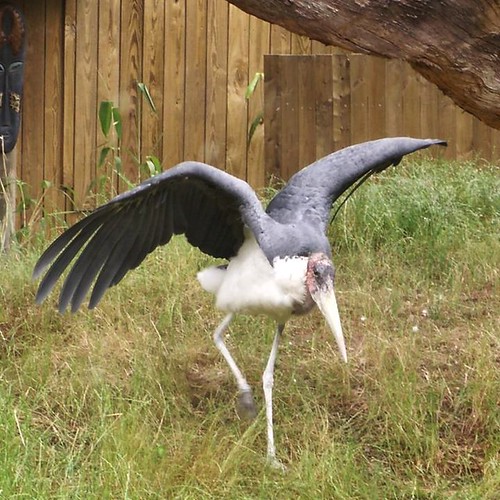
Marabou Stork
When does habitat become something in the eye of the beholder? And what does that mean?
Last night I photographed some of our local denizens, whose identities I know thanks to the folks at Bugguide.Net. They included a Pine Devil Moth and an Owlfly, along with a couple different species of Ground Beetle (whose North American species runs into the thousands, some of which are very difficult to tell apart).
I had never before seen the likes of the moth or the owlfly -- in fact, I had never before seen an owlfly, period. Mary, who had called my attention to the moth outside our local bakery at around 9:30 PM, wondered if we were seeing these critters because they were being driven from their natural habitats as our county rushes further into development.
I don't discount her theory but came up with my own: What if, in the midst of ongoing drought conditions, these creatures come into settled areas because that's where the water is?
I don't know which is correct, or which is more correct. We've been here for only three years. Some things have stayed the same, like the robins' return at the end of January. But other things change -- or maybe they haven't really changed but our attention has been redirected. Our first year here I don't remember seeing swallow-tailed kites in the neighborhood. The past two years, I have.
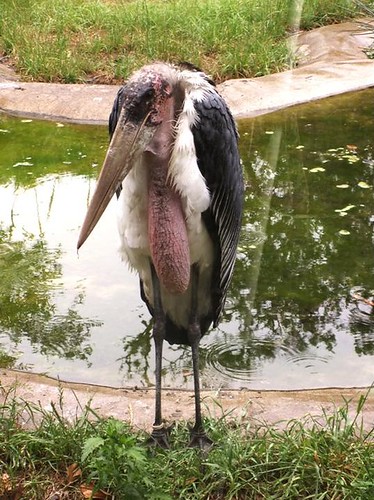
The Marabou Stork (Leptoptilos crumeniferus) is among several African birds on display at the St. Augustine Alligator Farm and Zoological Park. According to the info sign, this stork feeds primarily on amphibians, aquatic organisms, beetles, carrion, crustaceans, fish, flamingos, termites, and young shore birds. Its ability to adapt to human encroachment is probably helping its population to increase. Predominantly scavengers, Maribous are beneficial to reducing disease by cleaning up carcasses and other rubbish.
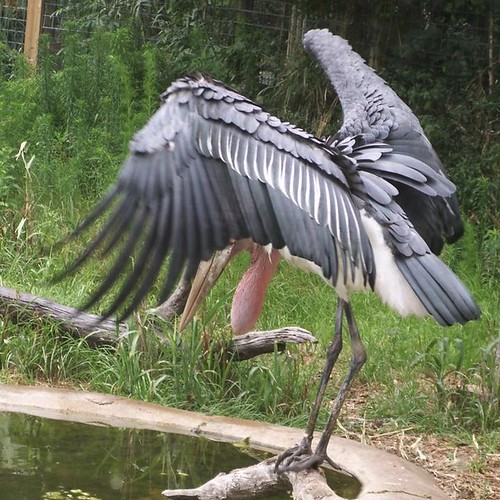
Says the park's plaque, "As if their bald head, crusty bill, and excrement-covered legs weren't ugly enough, these birds actually turn gruesome during the breeding season. The scabby spots on the face and forehead become encrusted with dried blood. They aggressively defend their nesting site while inflating two large subcutaneous air sacs. One bright pink medium-sized bulbous sac protrudes from the feathers of the upper back. A larger pendulous flesh-colored gular sac hangs below the throat when inflated. They do have one appealing feature during this time -- the back of the neck turns a beautiful pale-blue-green."
The Marabou was behind Plexiglas, along with two other species in the African Birds display: the Helmeted Guineafowl (which I couldn't photograph well), and the West African Crowned Crane (Balearica pavonina).
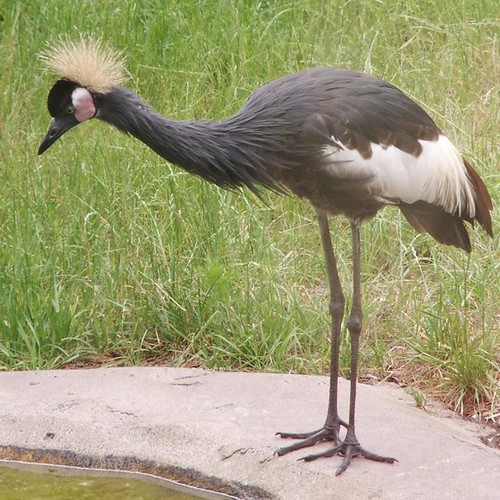
The crane feeds mainly on grasses, seeds, insects, and other small invertebrates. This bird prefers freshwater marshes, wetter grasslands, and the edges of water bodies.
The major threats facing this species are the loss, transformation, and degradation of habitat. Crane habitat, wetlands and grasslands, have been devastated by natural droughts and human impact. In recent years, the illegal capture for the international market has also caused major declines in population.
This bird is the national bird of Nigeria, where it is considered a symbol of good luck. In Kenya, it is believed to be a messenger of peace that also removes livestock pests and guards waterholes and swamps.
Of the two hornbills I photographed, one is commonly seen and the other might be considered threatened, though its exact numbers are unknown.
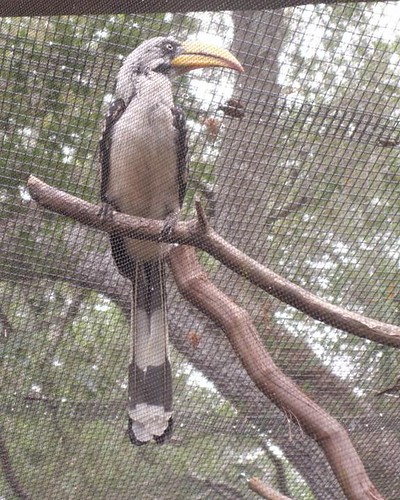
According to the park's plaque, the Yellow-Billed Hornbill (Tockus flavirostris) is one of the smallest hornbill species. It feeds on rodents, insects, scorpions and centipedes, and fruit. Its habitat is bushvelds, woodlands, and arid thornvelds of Central Eastern Africa.
During breeding season, the female seals herself into the nest cavity, leaving a narrow, vertical slit through which the male feeds her. Once sealed inside, the female lays and incubates her eggs. While in the nest, the female undergoes a full molt and cannot fly until her new feathers grow in. She doesn't leave the nest cavity until her chicks are old enough to fly.
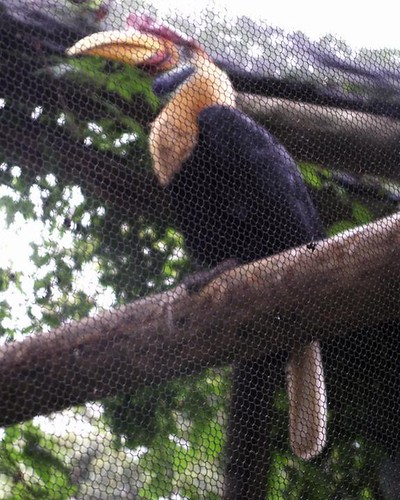
The Sulawesi Red-Knobbed Hornbill (Aceros cassidix) feeds mainly on figs, and has been known to fly over 20 miles in one day in search of fruiting trees. Its habitat is restricted to evergreen forests on the Indonesian island of Sulawesi.
It is difficult to accurately estimate the population of this species due to its nomadic nature. It is often seen congregating around fruiting trees. Counts based on groups of birds feeding may result in an exaggerated estimate of the population's true numbers. Says the plaque, "The loss of adequate habitat has no doubt affected the numbers of these birds in the wild." Like the Yellow-Billed Hornbill, this bird seals itself up in the nest cavity until her chicks become fully mobile.
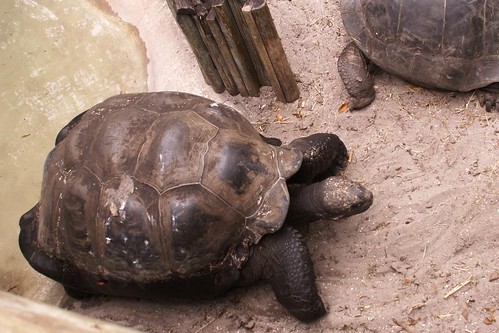
This is the second time I've photographed a Galapagos tortoise. The first time had been in the Galapagos Islands, which I was extraordinarily lucky to visit in the summer of 1984. I did not see them in the wild there, either, but at the Darwin Research Station on the island of Santa Cruz. This shot includes my photo of the tortoises there.
During my 1984 visit I was told that to protect the species from human-introduced dogs and rats, the research station collects hatchlings and raises them for five years before releasing them into the wild. At the station I saw small tortoises with shells the size of coasters, each shell painted with a number. It all looked like some kind of turtle derby.
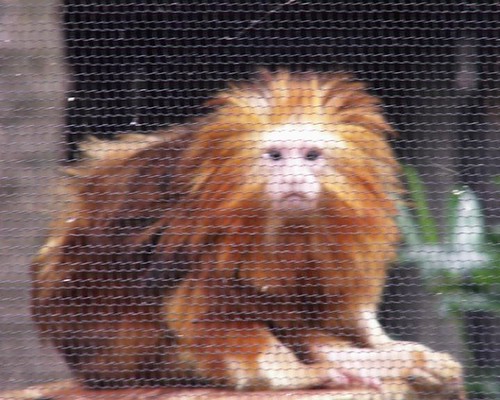
Under the plaque's heading for Conservation Status, the Golden-Headed Lion Tamarin (Leontopithecus chrysomelas) is listed as Critically Endangered.
This species is one of the most endangered of all primates. Endemic to Brazil's Atlantic forest, it endures constant threats of habitat loss and habitat fragmentation from severe deforestation. Currently, conservation efforts include identifying habitat corridors to link larger forests where Golden-headed Lion Tamarins now live. This would maximize genetic diversity and increase long-term survival of populations. Efforts are also being made to work with local landowners to encourage them to protect vital habitat.
This species differs from most other primates in that its feet have sharp claws instead of nails.
Back at our local habitat, I was waiting inside the bakery for its proprietor to return, because I'd heard he knew something about bird calls and I have this recording of a bird in the neighborhood whom I can't identify. Harry, who didn't recognize it, either, referred me to Florida Bird Sounds, a great site that informed me that one of the songs we've been hearing sometimes is that of a Carolina Wren. But that wasn't the call I recorded, and I couldn't find that sound at the site. For now, the bird remains a mystery.
Mary, meanwhile, had stepped outside. Soon, she called me to come to the front.
"You want to see this," she said. "It's big."

Pine Devil Moth, Citheronia sepulcralis. Family Saturniidae (Giant Silkworm and Royal Moths). According to Bugguide.Net, these moths range throughout eastern North America, more common in the southeast. "A little-known silk moth, but subtly beautiful." Its habitat is coniferous and mixed coniferous/deciduous forests. Bugguide shows June as the start of its season, so this one is a little early (June-August (one brood) in the north, June-September (two broods) farther south). Adults do not feed. Larvae feed on pines, Pinus species. Eggs are laid at the base of pine needles.
At first I had thought this was a Sphinx moth. Combing through Bugguide showed me some similarities to the Carolina, Catalpa, Walnut, and Fig Sphinx moths, but not an exact match. I hadn't realized I was looking at the wrong family. Patrick Coin set me right on the ID.

This one also looks like it's been in a battle or has a bad case of mange. Chances are it's a female because of its broad abdomen and narrow antennae.
The owlfly, hanging around outside the supermarket (where I'd provided a spider ID to one of the employees), was like nothing I'd ever seen before.
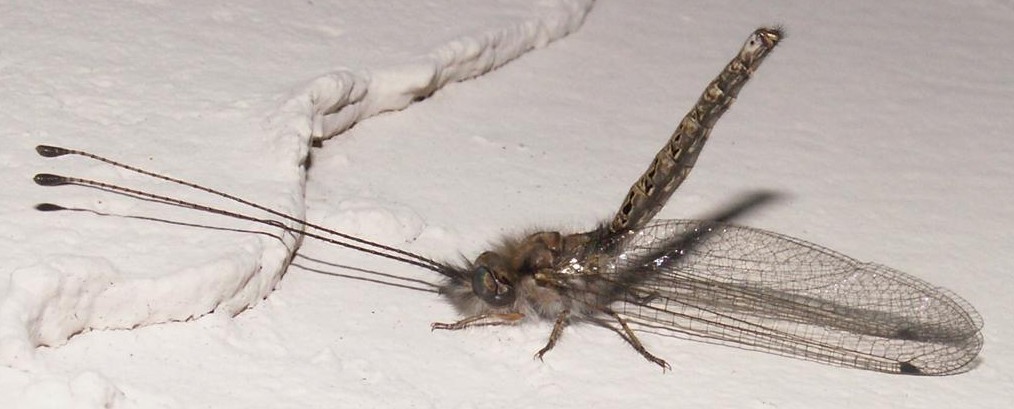
Family Ascalaphidae. Owlflies are often called a cross between a butterfly and a dragonfly. According to the University of Florida, 4 species of owlfly occur in Florida, of which 3 are in the genus Ululodes. Which this is, due to its divided eye.
(What's that, you say?)
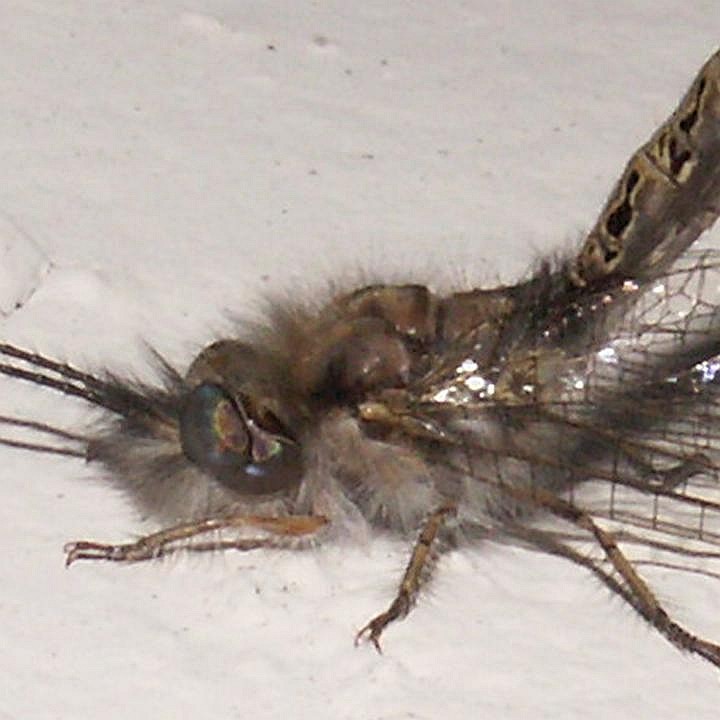
I couldn't figure out for the life of me what was going on with that eye until I'd read the description. Species is still unknown. I'm hoping it's Ululodes floridana, which seems not to have a photo available. I've pretty much ruled out quadrimaculatus, and the one photo I've seen of macleayana makes it difficult to tell whether that's the same species as the one here. This one is likely a male, due to its abdominal tufts and slender body.
Owlflies range through most of North America; the adults are said to prey on insects. Says Bugguide, "Eggs are laid on twigs. Larvae predatory, lie on ground covered with debris waiting for prey. Larvae resemble those of ant-lions, but have a 'finger-like appendage' on the side of each segment. Some genera actively cement sand and debris onto their bodies as camouflage. Pupation occurs in a silk cocoon in leaf litter."
Writes Coin, "We're really breaking new ground here--this family is poorly documented in North America, at least in any popular literature or on the Internet."
As for habitat changes -- I couldn't say whether these creatures are hanging out around the bakery and the supermarket because of rapid development. Or because of drought. Or for any other reason. What I can say is that my attention to bugs has mushroomed since I got this camera.
Earlier today three white ibises congregated on our neighbor's lawn across the street (we'd seen them do the same thing last year). We were pulling out of the driveway at the time, taking Daisy to a vet appointment, so I didn't have time to take photos -- especially since I was the one behind the wheel. We'd been concerned about Daisy's recent weight loss, but according to the vet she's fine and is not too thin. And that weird bump by her ribs is not a tumor, it's a kidney. We're waiting on test results that will provide more info.
Daisy's lungs sounded quite healthy for her 14 years. I was not about to stop, even in the driveway, to photograph the ibises with a kitty yowling in Mary's arms.
Last night our supermarket guy was disappointed. "It's a common spider?" He'd clearly wanted it to be more exotic. "It is common throughout Florida and much of the southern United States in human populated areas," says the University of Florida. Still, I'd never seen a Southern House Spider prior to Saturday night.
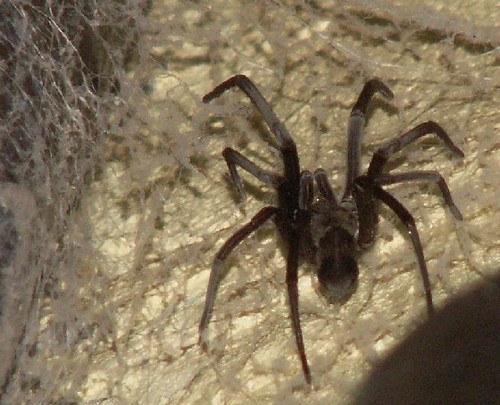
Mary was off to get a last item for purchase. I was waiting up front with our packages when I spotted and photographed a Green Cutworm Moth on the ceiling. It had been close to midnight and the store was all but empty, so when I looked back down I found myself surrounded by folks who wanted to know what I was doing. Then one of the employees guided me to the back storage room to show me a "weird spider."
This one is likely a Southern House Spider (Kukulcania hibernalis, Family Filistatidae (Crevice Weavers)). The dark coloration and large size (the body seems at least an inch long) make me think this one's a female. Males are smaller and lighter-colored, and are sometimes mistaken for the very poisonous brown recluse spiders, which are smaller still.
These (and various other Families) fall into the category of Cribellate spiders because of the type of web they weave. A good definition comes from Australian Museum Online: "Cribellate silk is produced from many tiny, silk glands placed beneath a specialised, flattened spinning organ called the cribellum....A web made with a meshwork of these composite 'wool-like' threads is particularly effective at tangling the bristles, spines and claws of insect prey. The fine fibrils of cribellate silk also appear to have some type of 'dry adhesive' properties (possibly electrostatic in nature) and will even cling to smooth beetle cuticle.... This remarkable innovation allowed spiders to produce the first specialised prey catching silk."
Coming up: The Alligator Farm Rookery.











2 Comments:
Fabulously fascinating from beginning to end... these simple journeys, with your camera and your knowledge, so rich!
Wonderful! I have only seen a couple of adult owl flies. The larvae must be really impressive since they are probably presumably carnivorous as are other neuropteran larvae.
Ironically, today I found a small neuropteran larva on a leaf. The larva had covered itself with leaf parts. Also I have antlions in my garden, but again they are pretty small.
Post a Comment
<< Home